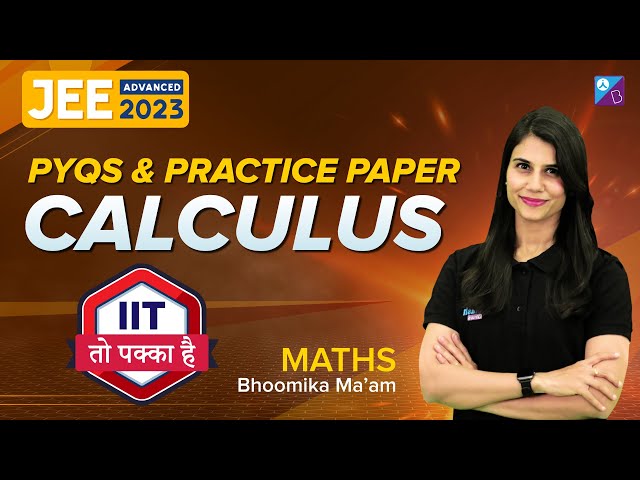Calculus is the branch of mathematics that deals with continuous change. Calculus is also called infinitesimal calculus or “the calculus of infinitesimals”. The meaning of classical calculus is the study of continuous change of functions. Most of these quantities are the functions of time such as velocity is equal to change in distance with respect to time. The two major concepts of calculus are:
The derivative is the measure of the rate of change of a function whereas integral is the measure of the area under the curve. The derivative explains the function at a specific point while the integral accumulates the discrete values of a function over a range of values.
| Table of Contents: |
Calculus Definition
Calculus, a branch of Mathematics, developed by Newton and Leibniz, deals with the study of the rate of change. Calculus Math is generally used in Mathematical models to obtain optimal solutions. It helps us to understand the changes between the values which are related by a function. Calculus Math mainly focused on some important topics such as differentiation, integration, limits, functions, and so on.
Calculus Mathematics is broadly classified into two different such:
- Differential Calculus
- Integral Calculus
Both the differential and integral calculus deals with the impact on the function of a slight change in the independent variable as it leads to zero. Both differential and integral calculus serves as a foundation for the higher branch of Mathematics known as “Analysis”. Calculus Mathematics plays a vital role in modern Physics as well as in Science and technology.
What is the Meaning of Calculus?
Calculus means the part of maths that deals with the properties of derivatives and integrals of quantities such as area, volume, velocity, acceleration, etc., by processes initially dependent on the summation of infinitesimal differences. It helps in determining the changes between the values that are related to the functions.
Basic Calculus
Basic Calculus is the study of differentiation and integration. Both concepts are based on the idea of limits and functions. Some concepts, like continuity, exponents, are the foundation of advanced calculus. Basic calculus explains about the two different types of calculus called “Differential Calculus” and “Integral Calculus”. Differential Calculus helps to find the rate of change of a quantity, whereas integral calculus helps to find the quantity when the rate of change is known.
Calculus Topics
Calculus Formulas PDF
There are many theorems and formulas in calculus. Some of the important formulas are given in the pdf below.
| Download PDF |
Differential Calculus Basics
Differential Calculus is concerned with the problems of finding the rate of change of a function with respect to the other variables. To get the optimal solution, derivatives are used to find the maxima and minima values of a function. Differential calculus arises from the study of the limit of a quotient. It deals with variables such as x and y, functions f(x), and the corresponding changes in the variables x and y. The symbol dy and dx are called differentials. The process of finding the derivatives is called differentiation. The derivative of a function is represented by dy/dx or f’ (x). It means that the function is the derivative of y with respect to the variable x. Let us discuss some of the important topics covered in the basic differential calculus.
Limits
The degree of closeness to any value or the approaching term. A limit is normally expressed using the limit formula as-
It is read as “the limit of f of x as x approaches c equals A”.
Derivatives
Instantaneous rate of change of a quantity with respect to the other. The derivative of a function is represented as:
Go through the links given below for Calculus Class 11 and class 12 concepts and get a detailed knowledge of basic calculus.
| Limits And Derivatives Class 11 Notes | Application Of Derivatives For Class 12 |
To learn more on calculus class 11 and calculus class 12, visit our BYJU’S page to get a proper definition with examples.
Continuity
A function f(x) is said to be continuous at a particular point x = a, if the following three conditions are satisfied –
- f(a) is defined
- \(\begin{array}{l}lim_{x \to a}f(x) \ exists\end{array} \)
- \(\begin{array}{l}lim_{x \to a^-}f(x) = lim_{x \to a^+}f(x) =f(a)\end{array} \)
Continuity and Differentiability
A Function is always continuous if it is differentiable at any point, whereas the vice-versa condition is not always true.
Quotient Rule
The Quotient rule is a method for determining the derivative (differentiation) of a function that is in fractional form.
Chain Rule
The rule applied for finding the derivative of the composition of a function is basically known as the chain rule.
Integral Calculus Basics
Integral calculus is the study of integrals and their properties. It is mostly useful for the following two purposes:
- To calculate f from f’ (i.e. from its derivative). If a function f is differentiable in the interval of consideration, then f’ is defined in that interval.
- To calculate the area under a curve.
Integration
Integration is the reciprocal of differentiation. As differentiation can be understood as dividing a part into many small parts, integration can be said as a collection of small parts in order to form a whole. It is generally used for calculating areas.
Definite Integral
A definite integral has a specific boundary within which function needs to be calculated. The lower limit and upper limit of the independent variable of a function is specified; its integration is described using definite integrals. A definite integral is denoted as:
Indefinite Integral
An indefinite integral does not have a specific boundary, i.e. no upper and lower limit is defined. Thus the integration value is always accompanied by a constant value (C). It is denoted as:
Indefinite Integration

Advanced Calculus
Advanced Calculus includes some topics such as infinite series, power series, and so on which are all just the application of the principles of some basic calculus topics such as differentiation, derivatives, rate of change and o on. The important areas which are necessary for advanced calculus are vector spaces, matrices, linear transformation. Advanced Calculus helps us to gain knowledge on a few important concepts such as
- Quadratic forms
- Generalized Stokes theorem
- Vector fields as derivatives
- Integration of forms
- Multilinear algebra
- Continuous differentiability
- Tangent space and normal space via gradients
- Dual space and dual basis
- Critical point analysis for multivariate functions, etc.
Applications of Calculus
Calculus is a Mathematical model, that helps us to analyze a system to find an optimal solution to predict the future. In real life, concepts of calculus play a major role either it is related to solve the area of complicated shapes, safety of vehicles, evaluating survey data for business planning, credit card payment records, or finding the changing conditions of a system affect us, etc. Calculus is a language of physicians, economists, biologists, architects, medical experts, statisticians and it is often used by them. For example, Architects and engineers use concepts of calculus to determine the size and shape of the curves to design bridges, roads and tunnels, etc. Using Calculus, some of the concepts are beautifully modelled, such as birth and death rates, radioactive decay, reaction rates, heat and light, motion, electricity, etc.
Problems and Solutions
Go through the below calculus problems to understand the process of differentiation and integration.
Problem 1: Let f(y) = ey and g(y) = 10y. Use the chain rule to calculate h′(y) where h(y) = f(g(y)).
Solution: Given,
f(y) = ey and
g(y) = 10y
First derivative above functions are
f'(y) = ey and
g'(y) = 10
To find: h′(y)
Now, h(y) = f(g(y))
h'(y) = f'(g(y))g'(y)
h'(y) = f'(10y)10
By substituting the values.
h'(y) = e10y x 10
or h'(y) = 10 e10y
Problem 2: Integrate sin 3x + 2x with respect to x.
Solution: Given instructions can be written as:
∫ sin 3x + 2x dx
Use the sum rule, which implies
∫ sin 3x dx+ ∫ 2x dx ……… Equation 1
Solve ∫ sin 3x dx first.
use substitution method,
let 3x = u => 3 dx = du (after derivation)
or dx = 1/3 du
=> ∫ sin 3x dx turned as∫ sin u X 1/3 du
or 1/3 ∫ sin u du
which is 1/3 (-cos u) + C, where C= constant of integration
Substituting values again, we get
∫ sin 3x dx= -cos(3x)/3 + C ……… Equation 2
Solve∫ 2x dx
∫ 2x dx = 2∫ x dx = 2 * x2/2 + C = x2 + C ……. Equation 3
Equation (1) => ∫ sin 3x dx+ ∫ 2x dx
= -cos(3x)/3 + x2 + C
Calculus Previous Year Questions – JEE Advanced

Video Lesson on Advanced Questions of Calculus

Practice Questions
|
Calculus Oneshot Revision – Part 1

Calculus Oneshot Revision – Part 2

Video Lessons on Class 12 Important Calculus Questions
Part 1

Part 2

Practice more questions on calculus class 11 and calculus class 12 topics such as limits and derivatives, integration using different methods, continuity etc. To learn more about calculus in Maths, register with BYJU’S – The Learning App today.
Frequently Asked Questions – FAQs
What is Calculus?
What is differential calculus?
f’(x) = dy/dx

Plz gave me some notes of maths class 12th
Please check: Maths notes for Class 12